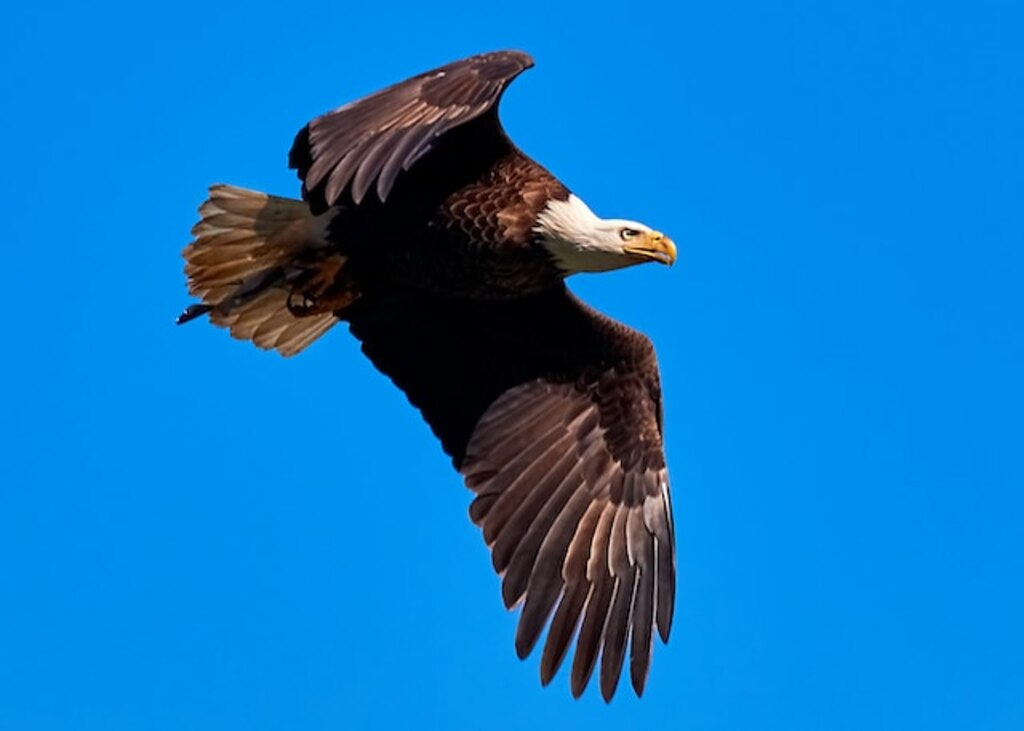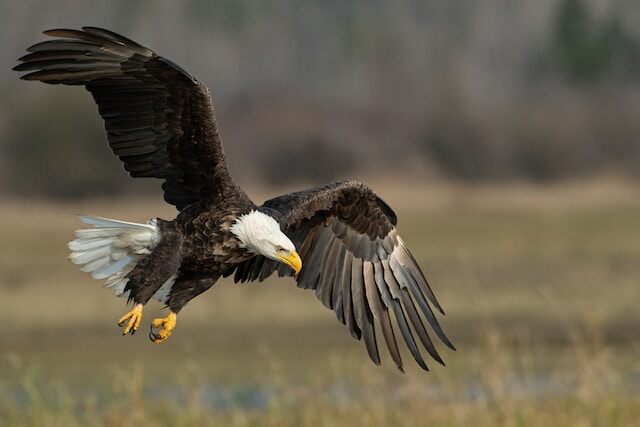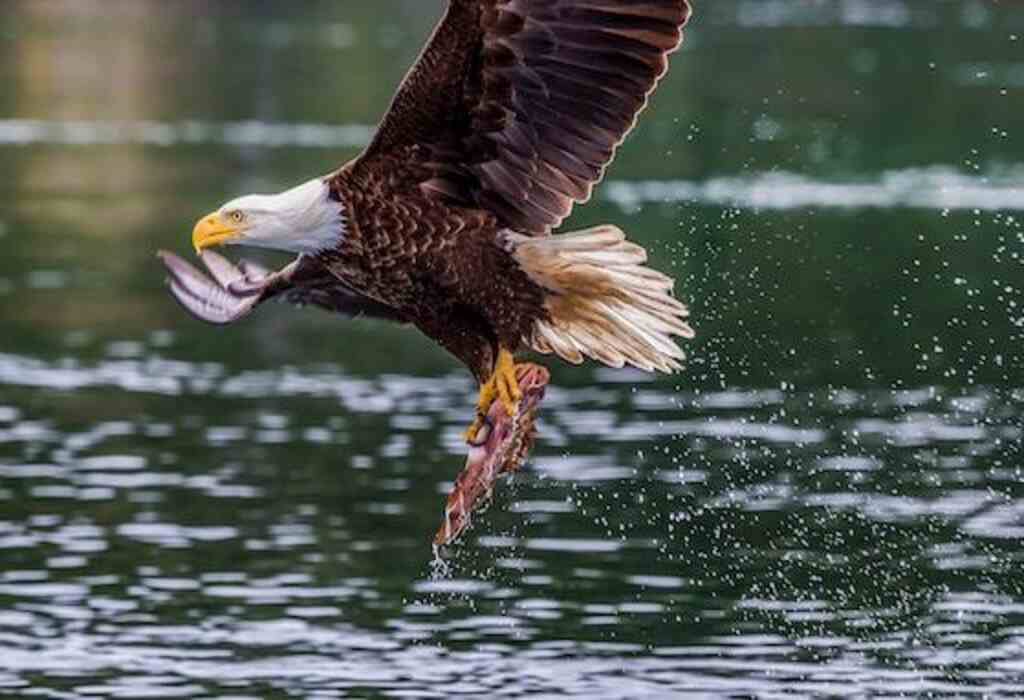Do Eagles Migrate? We’re all captivated by the freedom and wanderlust of birds, especially the mighty eagle—a symbol of strength, power, and freedom. But do these regal creatures migrate like their avian counterparts?
Join us as we unravel the secrets of eagle migration, exploring their species, patterns, and the significance of their journeys.
Brace yourself for an awe-inspiring adventure into the captivating world of eagle migration, revealing the cultural significance these majestic birds hold worldwide.
Table of Contents [show]
Key Takeaways
- Eagles do migrate, and understanding their migration patterns is crucial for their conservation.
- Environmental changes like habitat loss and climate change pose challenges to eagle populations, and low genetic diversity puts them at a higher risk of extinction.
- Studying eagle migration through tracking devices, observation, and data collection can inform conservation efforts, and citizen science plays a crucial role in this.
- Successful conservation programs involve multiple approaches like habitat protection, regulation and enforcement, and public awareness and advocacy.

Overview of Eagle Species
The various species of eagles are characterized by their unique physical features, distinct geographic ranges, and specific ecological niches.
These raptors are found on every continent except Antarctica, and their habitats range from the Arctic tundra to tropical rainforests.
Despite their diverse environments, eagles share similar population dynamics, with fluctuations in numbers due to factors such as food availability, predation, and habitat loss.
Understanding migration patterns is crucial in the conservation of eagle species, as these birds often face threats during their long-distance journeys.
By analyzing the routes, timing, and behavior of eagles during migration, researchers can develop effective conservation strategies to ensure their survival.
Do Eagles Migrate
Yes, eagles are known to migrate. They are among the bird species that undertake long-distance journeys between breeding and wintering grounds.
Eagles migrate to find better food sources, favorable climates, and suitable nesting sites.
Some species, like the bald eagle, can cover thousands of miles during their migratory journeys, displaying impressive navigation skills and endurance.
Migration patterns vary by species and region, with many eagles migrating in groups called kettles to maximize safety and efficiency.
Understanding Migration Patterns
Understanding migration patterns involves analyzing the movement of a species during specific times of the year.
For eagles, migration is a vital part of their life cycle as they move from one region to another in search of food, breeding grounds, and favorable weather conditions.
The migration of eagles is influenced by various factors such as changes in daylight hours, seasonal fluctuations in temperatures, and wind patterns.
However, climate change and human activities have also had a significant impact on eagle migration.
The effects of climate change on eagle migration include altered breeding seasons, changes in food availability, and the loss of habitat due to rising sea levels.
Human activities such as habitat destruction, pollution, and the use of pesticides have also affected eagle migration by reducing the availability of food and nesting sites.
These factors have led to a decline in eagle populations in some regions, making it crucial to understand and mitigate their effects.
Moving on to the subsequent section about factors affecting eagle migration, it is essential to note that eagles are highly adaptable and can adjust their migration patterns to changing conditions.
Factors that Affect Eagle Migration
Analyzing the ecological and environmental factors that influence the timing and direction of eagle migration is crucial for predicting their movements and developing effective conservation strategies.
Environmental changes such as temperature, precipitation, and food availability play a critical role in shaping avian behavior.
Eagles rely on these factors to determine when and where to migrate, as they need to find suitable habitats for breeding, feeding, and resting.
For instance, warmer temperatures can trigger earlier migration, while droughts or storms can delay or alter the direction of migration.
Additionally, eagles are highly sensitive to changes in their food sources, particularly fish and small mammals, which can affect their physical condition and energy reserves during migration.
Therefore, understanding how environmental factors affect eagle migration patterns is essential for managing their populations and protecting their habitats.
In the subsequent section, we will explore the importance of migration for eagles and how it relates to their survival and reproductive success.

The Importance of Migration for Eagles
Migration is a crucial aspect of survival and adaptation for eagles. It enables them to escape harsh weather conditions and find suitable habitats for breeding and feeding.
Additionally, migration promotes genetic diversity within eagle populations, reducing the risk of inbreeding and increasing the chances of species survival.
Lastly, eagle migration plays a vital role in maintaining ecosystem balance, as it facilitates the transfer of nutrients and energy across different regions, benefiting both eagles and their environment.
Survival and Adaptation
Survival and adaptation of eagles in their respective habitats have been extensively studied by scientists.
Adaptation strategies have allowed eagles to thrive in various environments, such as the bald eagle’s tolerance to cold and the golden eagle’s ability to soar at high altitudes.
However, environmental changes, such as habitat loss and climate change, can pose challenges to eagle populations.
For example, as prey populations decline, eagles may have to travel further distances to find food. Nevertheless, eagles have demonstrated their ability to adapt to changing conditions.
For instance, some bald eagles have shifted their diets from fish to scavenging on land animals.
Overall, the survival and adaptation of eagles is a complex and ongoing process that requires continuous monitoring and conservation efforts.
As we explore the topic of genetic diversity, it is important to consider how adaptation strategies have shaped the evolution of eagle populations.
Genetic Diversity
As we previously discussed, survival and adaptation are integral to the success of the eagle population. However, another crucial factor to consider is genetic diversity.
Through genetic analysis, scientists have found that populations with low genetic diversity are at a higher risk of extinction.
Breeding programs have been implemented to increase genetic diversity and ensure the long-term survival of the species.
This includes breeding programs for the bald eagle, which was once on the brink of extinction in the United States.
By introducing new genetic material from other populations, the eagles are able to maintain healthy genetic diversity and adapt to changing environmental conditions.
Understanding and preserving genetic diversity is crucial for the long-term survival of eagle populations.
Moving forward, it is important to consider the impact of human activities on the genetic diversity of eagle populations and take steps to protect their genetic diversity.
This is essential for maintaining ecosystem balance and ensuring a healthy, sustainable future for all species.
Ecosystem Balance
Maintaining ecosystem balance is crucial for the long-term sustainability and well-being of all species, including the eagle population.
One major factor in maintaining this balance is understanding predator, prey dynamics.
For example, eagles play an important role in controlling populations of smaller prey animals, such as fish, which helps to prevent overgrazing of underwater vegetation.
This in turn helps to maintain healthy aquatic ecosystems.
However, climate change is affecting both predator and prey populations, with rising temperatures leading to changes in migration patterns, food availability, and reproductive success.
This presents challenges faced by migratory eagles, who rely on predictable patterns of food availability and weather conditions to survive.
As we continue to study and understand the complex relationships between predators, prey, and the environment, we can work towards preserving the delicate balance of our ecosystems and ensuring the survival of species like the eagle.

Challenges Faced by Migratory Eagles
Migration of eagles poses various difficulties, including traversing long distances, encountering unfavorable weather conditions, and navigating through unfamiliar territories.
These challenges are exacerbated by factors like habitat loss, which limits the availability of suitable nesting and feeding sites.
During migration, eagles face a range of weather conditions, such as storms, high winds, and extreme temperatures, which can hinder their ability to fly and forage for food.
In addition, the unfamiliar landscapes and water bodies they encounter during migration can pose navigation challenges for these birds of prey.
Nevertheless, eagles have evolved a range of adaptations to overcome these challenges, such as relying on thermals to conserve energy, using visual cues to navigate, and adjusting their flight patterns based on weather conditions.
Understanding these challenges is crucial for developing effective conservation strategies to protect these iconic birds.
Scientists have developed a range of techniques for studying eagle migration, from satellite tagging to visual surveys, which provide important insights into the movements and behavior of these majestic birds.
How Scientists Study Eagle Migration
The study of eagle migration involves several methods, including the use of tracking devices, observation, and data collection.
Scientists attach tracking devices to migrating eagles to monitor their movements and study their behavior.
In addition, they also rely on observation and data collection from various sources, such as citizen science projects and collaborative efforts with other researchers.
These methods help researchers gain a better understanding of eagle migration patterns and the challenges they face.
Tracking Devices
Using satellite tags and GPS technology, researchers have been able to follow the movements of eagles like a virtual bird’s eye view.
This use of technology has allowed for a deeper understanding of the migration routes of eagles and their behavior during migration.
Through the tracking devices, researchers have discovered that eagles fly at incredible heights and speeds, sometimes covering thousands of miles in a single journey.
They have also found that eagles often use specific landmarks and geographical features to guide their migration, such as mountains and coastlines.
This knowledge has not only expanded our understanding of eagle migration but has also provided insight into how these birds interact with their environment.
As we move into the next section on observation and data collection, it will become clear how these technologies have allowed scientists to gather more accurate and comprehensive information about eagle migration patterns.
Observation and Data Collection
Having explored the use of tracking devices to study eagle migration, we now turn to the importance of observation and data collection in understanding the movement patterns of these magnificent birds.
Field techniques such as direct observation and the collection of feather samples can provide valuable information about the behavior and habitat preferences of eagles.
Data analysis allows researchers to identify patterns and trends in eagle migration, which can help inform conservation efforts.
By combining these methods, we can gain a more comprehensive understanding of eagle migration and work towards protecting these species.
Moving forward, collaboration between researchers and conservationists will be crucial in developing effective strategies to preserve the habitats of eagles and ensure their continued survival.
Collaborative Efforts
Collaboration between researchers and conservationists is essential in developing successful strategies for the protection and preservation of eagle habitats, ultimately ensuring the survival of these majestic birds.
Citizen involvement and community outreach are crucial components of these collaborative efforts, as they allow for a wider range of data collection and a better understanding of local eagle populations.
By working together, researchers and conservationists can identify key areas for protection and develop effective management plans that balance the needs of both the eagles and the communities in which they reside.
Additionally, community outreach initiatives can help raise awareness about the importance of eagle conservation and inspire individuals to take action in protecting these birds.
The role of citizen science in eagle research and conservation will be discussed in the subsequent section.

The Role of Citizen Science
Citizen science plays a crucial role in the study of eagle migration. One way citizens can contribute is by reporting eagle sightings to researchers, which can help track the birds’ movements and behavior.
Additionally, citizen scientists can assist in research by collecting data and monitoring eagle populations.
Education and outreach efforts are also important components of citizen science, as they can help spread awareness about the importance of eagle conservation and inspire more people to get involved in scientific research.
Reporting Eagle Sightings
One effective method for tracking eagle migration patterns is by reporting eagle sightings to local conservation organizations and wildlife agencies.
These organizations have established reporting protocols to ensure that the data collected is accurate and reliable.
Citizen science opportunities exist for individuals to contribute to the collection of this data.
By reporting eagle sightings, individuals can help to fill in gaps in knowledge about eagle migration patterns and contribute to ongoing research efforts.
This valuable information can then be used by researchers to better understand eagle behavior and inform conservation efforts.
Contributing to research in this way not only helps to protect these majestic birds but also contributes to our understanding of the natural world.
Contributing to Research
After reporting eagle sightings, citizen involvement can extend to contributing to research efforts to better understand eagle migration patterns.
Such involvement can have significant conservation impact, as it can lead to the development of targeted conservation strategies to protect eagle populations during migration.
Citizen scientists can help track eagle movements and gather data, which can be used to inform policy decisions and conservation efforts.
By engaging in such activities, citizens can not only contribute to scientific knowledge, but also play an active role in the protection of these iconic birds.
Moving forward, education and outreach efforts can be developed to encourage more citizen involvement in eagle conservation.
Education and Outreach
Efficient and effective outreach strategies and educational resources can play a vital role in encouraging engagement in eagle conservation.
To achieve this, outreach professionals can employ various tactics, including creating educational resources that provide detailed information about eagles, their habitat, and migration patterns.
Additionally, they can organize community events, such as birdwatching tours and environmental workshops, that help individuals develop a deeper understanding of eagles and their conservation needs.
Finally, using social media platforms to disseminate information can reach a broader audience and help create a sense of community around eagle conservation.
By leveraging these outreach strategies and educational resources, we can encourage more people to get involved in eagle conservation.
This, in turn, will help us better understand the needs of migratory eagles and develop more effective conservation efforts to protect them.
Conservation Efforts for Migratory Eagles
Conservation efforts for migratory eagles involve multiple approaches, including habitat protection, regulation and enforcement, and public awareness and advocacy.
Habitat protection is an important aspect of conservation efforts, as it ensures that eagles have a safe and suitable environment to breed and hunt.
Regulation and enforcement of laws and policies that protect eagles from human activities such as hunting and habitat destruction is also crucial.
Finally, public awareness and advocacy play a key role in promoting conservation efforts and ensuring that eagles receive the protection they need.
Habitat Protection
Preservation of important habitat areas is crucial for the survival of eagles during their migratory journeys.
The importance of conservation efforts cannot be overstated, as it helps to maintain the natural balance of ecosystems that support eagle populations.
Habitat restoration plays a vital role in this effort, as it helps to repair damaged habitats and create new ones.
Some of the key ways in which habitat protection is achieved include the establishment of protected areas, the use of conservation easements, and the implementation of sustainable land-use practices.
By protecting these important habitats, we are not only ensuring the survival of eagles during their migratory journeys, but also preserving the natural beauty of these areas for generations to come.
As we move forward with these efforts, it’s important to remember that the conservation of habitat areas is an ongoing process that requires the cooperation of individuals, communities, and governments.
This is where regulation and enforcement come into play, as we must ensure that these efforts are carried out in a responsible and sustainable manner.
Regulation and Enforcement
As we discussed in the previous section, habitat protection plays a vital role in safeguarding eagles and their ecosystem. However, it is not the only measure needed to ensure their survival.
Regulation and enforcement are equally important in preserving the species.
The effectiveness of enforcing laws and regulations related to eagle protection is crucial in preventing illegal activities such as poaching.
The government has implemented several regulations to protect eagles, including the Bald and Golden Eagle Protection Act and Migratory Bird Treaty Act.
The effectiveness of these measures depends on the level of enforcement, which has been a challenge in some areas.
Increasing the effectiveness of enforcement and poaching prevention will help protect eagles and their habitat.
Moving forward, we will discuss the crucial role of public awareness and advocacy in eagle conservation.
Public Awareness and Advocacy
Public awareness and advocacy play a crucial role in raising awareness about the importance of eagle conservation and promoting policies that support their protection.
Advocacy campaigns and awareness programs are effective ways to engage with the public and encourage them to take action to protect eagles.
One of the most successful advocacy campaigns is the Bald Eagle Protection Act, which has been instrumental in the recovery of the bald eagle population in the United States.
Other examples of successful awareness programs include educational initiatives that teach people about the importance of eagle habitat preservation and the negative effects of human activities on eagle populations.
Additionally, advocacy groups work to influence policy at the local, state, and national levels to ensure that laws and regulations are in place to protect eagles and their habitats.
These efforts have led to increased public support for conservation efforts and have helped to create a more favorable environment for eagles.
As we will see in the subsequent section about examples of successful conservation programs, these advocacy campaigns and awareness programs have been critical in the recovery of eagle populations.

Examples of Successful Conservation Programs
One effective approach to safeguarding endangered species is akin to planting a seed in fertile soil, as exemplified by the successful conservation programs implemented for the bald eagle, peregrine falcon, and California condor.
These birds of prey were once on the brink of extinction, but through a combination of conservation strategies, including habitat restoration, captive breeding programs, and public education, their populations have rebounded.
The bald eagle, for example, was removed from the endangered species list in 2007, thanks to the efforts of conservationists and government agencies.
The peregrine falcon, which was also listed as endangered, has similarly made a remarkable recovery.
The California condor, once down to just 27 individuals, now numbers over 500, thanks to intensive captive breeding and release programs.
These success stories demonstrate that with the right combination of science, public awareness, and political will, it is possible to reverse the decline of endangered species.
Looking to the future, there is hope that the same strategies can be applied to other species, such as the eagle, to ensure that they continue to thrive in the wild.
Future Prospects for Eagle Migration
The future prospects for the migration of eagles appear promising as continued conservation efforts and habitat restoration initiatives are underway.
With an increased awareness of the importance of preserving the natural environment, there is hope that eagles will continue to thrive in their natural habitats.
Climate change poses a significant threat to the future of eagle migration, and it is essential to implement strategies that mitigate the impact of climate change on eagle populations.
Additionally, technology advancements have made it possible to track and monitor eagle populations, providing valuable insights into their behavior and habitat requirements.
A deeper understanding of eagle migration patterns and their habitat needs can inform conservation strategies that protect these majestic birds.
Supporting conservation efforts through volunteering, education, and advocacy can further strengthen the prospects for eagle migration and ensure that future generations can enjoy the sight of these magnificent birds in the wild.
How to Support Eagle Conservation
Supporting eagle conservation efforts can be achieved through various means, such as donating to reputable organizations, participating in citizen science projects, and advocating for policies that protect eagle habitats.
Volunteer opportunities are also available for those who wish to be more hands-on in their approach to eagle conservation.
These opportunities can include tasks such as monitoring eagle populations, assisting with habitat restoration projects, and conducting educational programs.
Fundraising initiatives can also be a powerful way to support eagle conservation efforts, with proceeds going towards research, habitat protection, and community outreach programs.
It is important to note that eagles hold cultural significance for many communities, and efforts to protect them can also have a positive impact on these communities.
By taking action to support eagle conservation, individuals can help ensure that these majestic birds are able to thrive for generations to come.
As we move into the subsequent section about eagle migration and cultural significance, it is important to recognize the role that conservation efforts play in maintaining the health and vitality of eagle populations.

Eagle Migration and Cultural Significance
Eagle migration is like a natural phenomenon that has captivated the attention and admiration of various cultures worldwide due to its symbolic and spiritual significance.
In many cultures, eagles are viewed as powerful and majestic creatures that represent freedom, strength, and courage.
They are revered for their ability to soar high in the sky and navigate great distances, which has led to their association with the divine and the supernatural.
For example, in Native American cultures, the eagle is considered a messenger to the gods and is often depicted in art and storytelling.
Similarly, in ancient Greek mythology, the eagle was the embodiment of Zeus, the king of the gods.
Even today, the cultural significance of eagle migration continues to be celebrated through traditional beliefs, rituals, and ceremonies.
For instance, in some communities, the arrival of eagles is seen as a sign of good luck and prosperity, while their departure signifies the end of a particular season or cycle.
Overall, the cultural significance of eagle migration highlights the deep connection between humans and nature, and reminds us of the importance of preserving these magnificent birds and their habitats for generations to come.
Frequently Asked Questions
How do eagles hunt for prey during migration?
Eagles employ a variety of hunting techniques during migration, including soaring, hovering, and stooping. Prey selection often depends on availability, with eagles targeting small mammals, fish, and birds. These skills are essential for survival and maintaining energy during long journeys.
Are there any eagle species that do not migrate?
Several eagle species, such as Bald and Golden Eagles, exhibit migratory behavior. However, there are some species, such as the Philippine Eagle and Harpy Eagle, that primarily inhabit one area year-round and do not exhibit migratory patterns.
Do eagles mate during migration?
Eagles adhere to a strict breeding schedule, with mating habits occurring prior to migration. During this time, they establish a monogamous relationship with a partner and produce offspring, ensuring the continuation of their species.
Eagle navigation during migration is guided by their magnetic field sensitivity. By sensing the Earth’s magnetic field, eagles can determine their position and orient themselves towards their destination. This allows for precise and efficient navigation without relying on visual landmarks.
Can eagles fly in formation during migration to conserve energy?
Flight patterns and social behavior are important factors to consider when exploring eagle migration beyond energy conservation. Eagles have been observed flying in formation during migration, suggesting a level of coordination and social behavior.

Conclusion
In conclusion, the migration of eagles is a complex and fascinating phenomenon that plays a crucial role in the survival and well-being of these majestic birds.
Through their annual journeys, eagles not only seek out food and suitable breeding grounds but also maintain genetic diversity and population stability.
However, eagle migration is not without its challenges, as natural and human-made factors can disrupt these birds’ journeys and threaten their survival.
Despite these challenges, there is hope for the future of eagle migration, thanks to successful conservation efforts and ongoing research into the factors that affect these birds’ movements.
By supporting these initiatives and taking steps to reduce human impact on the environment, we can help ensure that eagles continue to grace our skies for generations to come.
In the end, the migration of eagles is not just a scientific phenomenon, but a powerful allegory for the resilience and adaptability of nature in the face of adversity.
It reminds us that, even in the darkest of times, there is always hope for renewal and growth, and that with determination and cooperation, we can overcome the challenges that threaten our planet’s biodiversity.
So let us cherish and protect these magnificent birds, and work together to create a brighter future for all living beings.




